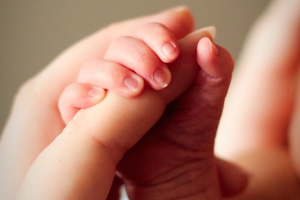Delivery of the Baby
Delivery is the moment when it’s time to welcome your baby into the world.
At this point, the mother delivers the baby, followed by the delivery of the placenta.
Fathers or partners are encouraged to be actively involved in the childbirth process by helping the mother with relaxation and breathing exercises.
Positions for delivery may vary from squatting to sitting to semi-sitting positions (between lying down and sitting up). The type of position for delivery depends on the preference of both the mother and the health care provider, as well as the health of the baby. With semi-sitting positions, gravity can help the mother push the baby through the birth canal.
During delivery, the medical team will monitor the mother's vital signs, like blood pressure and pulse in additionto the baby’s heart rate.
The health care team will examine the mother’s cervical opening to determine the position of the baby’s head. The team will continue to support and guide the mother in her pushing efforts.
Types of Delivery
Vaginal Delivery
During a vaginal delivery, when the baby’s head and chin become visible, the health care provider will support and guide them out of the vagina.
Once the head is delivered, the health care provider pushes downward gently on the head to deliver the shoulder, followed by the rest of the body. The baby will turn itself at the last movement of labor.
In some cases, the vaginal opening does not stretch enough to accommodate the baby.
 It may be necessary to speed up delivery, for example, if the baby is in distress. In such cases, the health care provider may perform an
episiotomy,
which is a cut through the vaginal wall and the perineum and is necessary to help deliver the baby. Episiotomies are not needed for every delivery and are not routinely performed.
It may be necessary to speed up delivery, for example, if the baby is in distress. In such cases, the health care provider may perform an
episiotomy,
which is a cut through the vaginal wall and the perineum and is necessary to help deliver the baby. Episiotomies are not needed for every delivery and are not routinely performed.
Following the delivery of the baby, the mother will continue to push during the next few uterine contractions to deliver the placenta. Once the placenta is delivered, any tear or episiotomy is repaired.
The mother is usually given medication either by an injection into the muscles or intravenously that is used to contract the uterus.
The uterus is then massaged to help with the contraction and to help prevent excessive bleeding.
Cesarean section (C-section)
For some women, the baby may be delivered surgically by performing a cesarean section.
Some C-sections are planned and scheduled, while others may be performed as a result of complications that occur during labor.
C-sections are performed in an operating room. Usually, local anesthesia is given to the mother prior to starting the C-section, though general anesthesia may be used if the surgical team feels it is best.
Once the mother is ready, an incision is made in the stomach and an opening is made in the uterus. The amniotic sac is opened and the baby is delivered through the opening. The mother may feel some pressure and/or a pulling sensation.
Following the delivery of the baby, the health care provider will stitch the uterine incision and the incision that was made in the abdomen.
Conditions for a cesarean section
There are several conditions that may make having a baby by C-section more likely. These include:
- Previous C-section
- Ditress experienced by the baby (signs that the baby may not be doing well)
- Abnormal delivery presentation, like breech, shoulder, or face
- A labor that fails to progress or does not progress normally
- Placental complications. One example is placenta previa where the placenta blocks the cervix and raises the risk that the placenta will detach from the uterus too soon.
- Twins or other multiples
